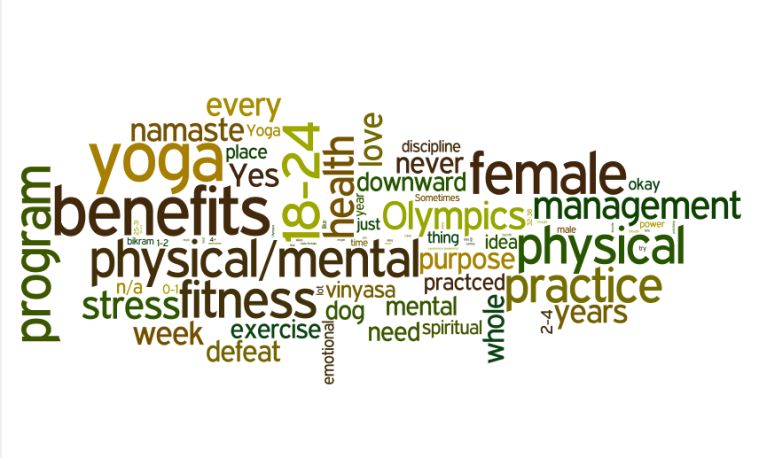Journalism changes day-to-day nowadays, and one of the coolest things about journalism is its delving into data. Comment boxes, open questions and surveys allow us to create visualizations about trends, likes, dislikes, history and basic information. And that’s what I did here: I sent out a survey (which, if you participated, THANK YOU!) and created visualizations out of my answers. Click on the graphs to be taken to a more detailed version; I hope you find these relationships and visualizations as interesting as I have. I will be distributing out another survey soon for my final in my multimedia class (I promise I’ll keep this blog going once the semester is going!), so stay tuned!
View Surveygoers in a full screen map
First, above is a link to a map of the hometowns of 11 of the over 20 people that took my yoga survey. Check it out, and next time you could be on it!
Next, above is a word visualization. The larger the word, the more frequently it came up in the survey questions and answers.
 Purple: mental health benefits
Purple: mental health benefits
Green: physical benefits
Mustard: emotional health benefits
Above: A matrix chart of the relationship between what brought people to practice yoga in the first place (stress management, physical exercise, a spiritual experience) and what the people within these categories felt the best benefit of yoga is.
 Green: mental health benefits
Green: mental health benefits
Blue: physical health benefits
Red: emotional health benefits
Above: A multi-faceted matrix chart detailing the relationship between what brought people to practice yoga in the first place (stress management, physical exercise, a spiritual experience) and what the people within these categories felt the best benefit of yoga is. This relationship is then broken up into categories of what my survey participants think yoga is, a spiritual discipline or a mental/physical fitness program.
 Blue: I’m confused, doesn’t that defeat the purpose of yoga?
Blue: I’m confused, doesn’t that defeat the purpose of yoga?
Green: Yoga in the Olympics is an okay idea.
Red: yoga has no place in the Olympics.
Tan: yoga in the Olympics is an awesome idea!
Above: A matrix chart shows the percentages of surveygoers that practice yoga on various levels, and in those percents, what those people thought about the idea of yoga in the Olympics (which is not happening, but what people said was interesting nonetheless).




